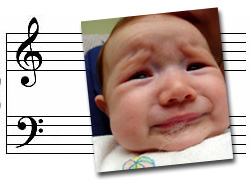 David Hockney Portraits in Boston—So Good!
David Hockney Portraits in Boston—So Good!
Jim develops another new love besides his
grandson.
I have to admit it. I'm fascinated with,
attracted to, amazed by, and can't get enough of the art of David Hockney! I
came late to this appreciation, even though artist friend Wayne was long ago
talking about his landscapes, his swimming pools and his photo
collages.
My last late great gay artiste affliction was Keith Haring. I read several bios on him, got every picture book I could, visited his website, and plastered my walls with his posters. And I have to admit, part of the fascination with Haring was that his art is so gay, with all those images of cocks and guys loving each other and death by AIDS. I mean, I have lost my share of gay friends to AIDS. It is nice to see gay-friendly images of male-male love.
But while Haring was clearly a gay artist, Hocking is a fabulous artist—maybe a genius, how would I know—who just happens to be gay. He's been cranking out art at an incredible rate, both in volume and genre, for well over forty years now. Stephen and I were lucky to see the closing of the show "David Hockney Portraits" at the Boston Museum of Fine Arts on May 12. There are about 200 pieces of art in this show, depending on how you count them. This collection alone, I would think, would make it clear to any art lover what a monumentally creative and boundary breaking artist we have in David Hocking. There is no way I can cover this show either fairly or authoritatively, but I will tell you about some my favorite art in this show.
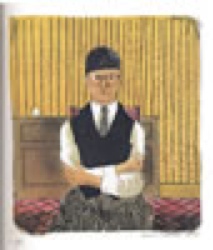 Four self portraits from 1954 demonstrate clearly that Hockney was a master
artist even at the tender age of 16. The show carries us into the early sixties
with a startling etched and engraved series titled
A Rake's Progress,
inspired by a series published by William
Hogarth in 1735. According to an article by Barbara Stern Shapiro in the show
catalog, "Hockney transformed the tale of an aristocrat who squandered his
wealth into himself as a young gay man struggling to find his niche in New York
City."
Four self portraits from 1954 demonstrate clearly that Hockney was a master
artist even at the tender age of 16. The show carries us into the early sixties
with a startling etched and engraved series titled
A Rake's Progress,
inspired by a series published by William
Hogarth in 1735. According to an article by Barbara Stern Shapiro in the show
catalog, "Hockney transformed the tale of an aristocrat who squandered his
wealth into himself as a young gay man struggling to find his niche in New York
City."
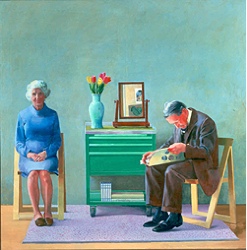 His parents are often the subject of his art, indeed, his mother sat for him
even at advanced age. One quite impressive large oil portrait titled
My
Parents made in 1977 was in the show, and will
have to suffice to show what a fine realistic portraitist is Hockney. Throughout
the show we see many of these large and even larger portraits of couples,
showing with astonishing depth and clarity not only the "vibes" of the people
being portrayed, but also a tangible aspect of their relationship. My favorite
of these was the acrylic canvas titled Mr. and Mrs. Clark and Percy done in
1970-71. At 84 x 120 inches, it fairly overwhelms the viewer. Incidentally, Ms.
Clark was Hockney's friend, Celia Birtwell, a textile designer known for her own
work, and the subject of several Hockney lithographs and drawings. Also of
interest are his portraits of gay male
couples.
His parents are often the subject of his art, indeed, his mother sat for him
even at advanced age. One quite impressive large oil portrait titled
My
Parents made in 1977 was in the show, and will
have to suffice to show what a fine realistic portraitist is Hockney. Throughout
the show we see many of these large and even larger portraits of couples,
showing with astonishing depth and clarity not only the "vibes" of the people
being portrayed, but also a tangible aspect of their relationship. My favorite
of these was the acrylic canvas titled Mr. and Mrs. Clark and Percy done in
1970-71. At 84 x 120 inches, it fairly overwhelms the viewer. Incidentally, Ms.
Clark was Hockney's friend, Celia Birtwell, a textile designer known for her own
work, and the subject of several Hockney lithographs and drawings. Also of
interest are his portraits of gay male
couples.
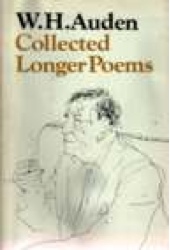 Also quite impressive are Hockney's line drawings, of which quite a few are in
the show, including the poet H. W. Auden, art dealer Henry Geldzahler, and a
couple of erotic drawings of former lover Peter Schlessinger. Over the years
Hockney experimented with a broad variety of drawing and sketching techniques,
including many works made using the renaissance device called a
camera
lucida.
He practiced for six months, and
eventually perfected a technique of quickly outlining the subject using the
device and then filling in the drawing with spontaneous marks. A series of
drawings made of various security guards is included in the
show.
Also quite impressive are Hockney's line drawings, of which quite a few are in
the show, including the poet H. W. Auden, art dealer Henry Geldzahler, and a
couple of erotic drawings of former lover Peter Schlessinger. Over the years
Hockney experimented with a broad variety of drawing and sketching techniques,
including many works made using the renaissance device called a
camera
lucida.
He practiced for six months, and
eventually perfected a technique of quickly outlining the subject using the
device and then filling in the drawing with spontaneous marks. A series of
drawings made of various security guards is included in the
show.
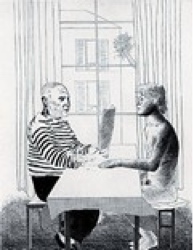 Hockney has had a long fascination with Picasso and cubism, graphically
illustrated in the 1973 Artist and
Model, which portrays a clothed Picasso and a
nude Hockney seated at a table. Some of his portraits show the subject
simultaneously from two points of view through a kind of superposition. This is
not, however, the main trend of his portraiture.
Hockney has had a long fascination with Picasso and cubism, graphically
illustrated in the 1973 Artist and
Model, which portrays a clothed Picasso and a
nude Hockney seated at a table. Some of his portraits show the subject
simultaneously from two points of view through a kind of superposition. This is
not, however, the main trend of his portraiture.
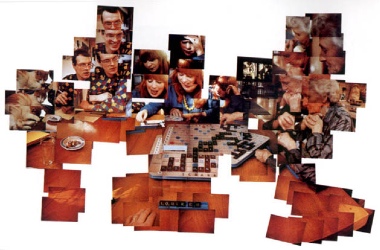
Hockney is also famous for his creation of artworks from collages of photographs, several of which were in the show. The Scrabble Game, 1983, is shown here, and you can see how Hockney further elaborates the central cubist goal of representing an object which has three spatial and one time dimension on a two dimensional canvas or in three dimensional space. Personally, I find that these collages speak volumes about the fuller nature of our existence, viewed from a single vantage point. In fact, Hockney makes it clear in his book That's the way I see it that he is quite conversant with both philosophy and the important quantum theoretic discoveries by 20th Century physicists. It shows in his art work.
 There is so much more in this show than what I have conveyed here. The forward
by Malcom Rogers (Director of the Boston Museum of Fine Arts), Bruce Robertson
(Deputy Director of the Los Angeles County Museum of Art) and Sandy Nairne
(Director, National Portrait Gallery, London) makes it clear that many important
people were involved in the production of this impressive show. And it is
equally clear that David Hockney's art, heart and thought encompass much more
than his portraiture. How amazing it must be to be a great man like David
Hockney. Never was it more clear to me than through the existence of David
Hockney in this world that you simply cannot see a person by looking at him or
her. What you have to see to see the person is the person's seeing. We have at
least some of that in Hockney's enormous oeuvre. David Hockney, I bow to
you.
There is so much more in this show than what I have conveyed here. The forward
by Malcom Rogers (Director of the Boston Museum of Fine Arts), Bruce Robertson
(Deputy Director of the Los Angeles County Museum of Art) and Sandy Nairne
(Director, National Portrait Gallery, London) makes it clear that many important
people were involved in the production of this impressive show. And it is
equally clear that David Hockney's art, heart and thought encompass much more
than his portraiture. How amazing it must be to be a great man like David
Hockney. Never was it more clear to me than through the existence of David
Hockney in this world that you simply cannot see a person by looking at him or
her. What you have to see to see the person is the person's seeing. We have at
least some of that in Hockney's enormous oeuvre. David Hockney, I bow to
you.
Jim Andris
My last late great gay artiste affliction was Keith Haring. I read several bios on him, got every picture book I could, visited his website, and plastered my walls with his posters. And I have to admit, part of the fascination with Haring was that his art is so gay, with all those images of cocks and guys loving each other and death by AIDS. I mean, I have lost my share of gay friends to AIDS. It is nice to see gay-friendly images of male-male love.
But while Haring was clearly a gay artist, Hocking is a fabulous artist—maybe a genius, how would I know—who just happens to be gay. He's been cranking out art at an incredible rate, both in volume and genre, for well over forty years now. Stephen and I were lucky to see the closing of the show "David Hockney Portraits" at the Boston Museum of Fine Arts on May 12. There are about 200 pieces of art in this show, depending on how you count them. This collection alone, I would think, would make it clear to any art lover what a monumentally creative and boundary breaking artist we have in David Hocking. There is no way I can cover this show either fairly or authoritatively, but I will tell you about some my favorite art in this show.
 Four self portraits from 1954 demonstrate clearly that Hockney was a master
artist even at the tender age of 16. The show carries us into the early sixties
with a startling etched and engraved series titled
A Rake's Progress,
inspired by a series published by William
Hogarth in 1735. According to an article by Barbara Stern Shapiro in the show
catalog, "Hockney transformed the tale of an aristocrat who squandered his
wealth into himself as a young gay man struggling to find his niche in New York
City."
Four self portraits from 1954 demonstrate clearly that Hockney was a master
artist even at the tender age of 16. The show carries us into the early sixties
with a startling etched and engraved series titled
A Rake's Progress,
inspired by a series published by William
Hogarth in 1735. According to an article by Barbara Stern Shapiro in the show
catalog, "Hockney transformed the tale of an aristocrat who squandered his
wealth into himself as a young gay man struggling to find his niche in New York
City." His parents are often the subject of his art, indeed, his mother sat for him
even at advanced age. One quite impressive large oil portrait titled
My
Parents made in 1977 was in the show, and will
have to suffice to show what a fine realistic portraitist is Hockney. Throughout
the show we see many of these large and even larger portraits of couples,
showing with astonishing depth and clarity not only the "vibes" of the people
being portrayed, but also a tangible aspect of their relationship. My favorite
of these was the acrylic canvas titled Mr. and Mrs. Clark and Percy done in
1970-71. At 84 x 120 inches, it fairly overwhelms the viewer. Incidentally, Ms.
Clark was Hockney's friend, Celia Birtwell, a textile designer known for her own
work, and the subject of several Hockney lithographs and drawings. Also of
interest are his portraits of gay male
couples.
His parents are often the subject of his art, indeed, his mother sat for him
even at advanced age. One quite impressive large oil portrait titled
My
Parents made in 1977 was in the show, and will
have to suffice to show what a fine realistic portraitist is Hockney. Throughout
the show we see many of these large and even larger portraits of couples,
showing with astonishing depth and clarity not only the "vibes" of the people
being portrayed, but also a tangible aspect of their relationship. My favorite
of these was the acrylic canvas titled Mr. and Mrs. Clark and Percy done in
1970-71. At 84 x 120 inches, it fairly overwhelms the viewer. Incidentally, Ms.
Clark was Hockney's friend, Celia Birtwell, a textile designer known for her own
work, and the subject of several Hockney lithographs and drawings. Also of
interest are his portraits of gay male
couples. Also quite impressive are Hockney's line drawings, of which quite a few are in
the show, including the poet H. W. Auden, art dealer Henry Geldzahler, and a
couple of erotic drawings of former lover Peter Schlessinger. Over the years
Hockney experimented with a broad variety of drawing and sketching techniques,
including many works made using the renaissance device called a
camera
lucida.
He practiced for six months, and
eventually perfected a technique of quickly outlining the subject using the
device and then filling in the drawing with spontaneous marks. A series of
drawings made of various security guards is included in the
show.
Also quite impressive are Hockney's line drawings, of which quite a few are in
the show, including the poet H. W. Auden, art dealer Henry Geldzahler, and a
couple of erotic drawings of former lover Peter Schlessinger. Over the years
Hockney experimented with a broad variety of drawing and sketching techniques,
including many works made using the renaissance device called a
camera
lucida.
He practiced for six months, and
eventually perfected a technique of quickly outlining the subject using the
device and then filling in the drawing with spontaneous marks. A series of
drawings made of various security guards is included in the
show. Hockney has had a long fascination with Picasso and cubism, graphically
illustrated in the 1973 Artist and
Model, which portrays a clothed Picasso and a
nude Hockney seated at a table. Some of his portraits show the subject
simultaneously from two points of view through a kind of superposition. This is
not, however, the main trend of his portraiture.
Hockney has had a long fascination with Picasso and cubism, graphically
illustrated in the 1973 Artist and
Model, which portrays a clothed Picasso and a
nude Hockney seated at a table. Some of his portraits show the subject
simultaneously from two points of view through a kind of superposition. This is
not, however, the main trend of his portraiture.

Hockney is also famous for his creation of artworks from collages of photographs, several of which were in the show. The Scrabble Game, 1983, is shown here, and you can see how Hockney further elaborates the central cubist goal of representing an object which has three spatial and one time dimension on a two dimensional canvas or in three dimensional space. Personally, I find that these collages speak volumes about the fuller nature of our existence, viewed from a single vantage point. In fact, Hockney makes it clear in his book That's the way I see it that he is quite conversant with both philosophy and the important quantum theoretic discoveries by 20th Century physicists. It shows in his art work.
 There is so much more in this show than what I have conveyed here. The forward
by Malcom Rogers (Director of the Boston Museum of Fine Arts), Bruce Robertson
(Deputy Director of the Los Angeles County Museum of Art) and Sandy Nairne
(Director, National Portrait Gallery, London) makes it clear that many important
people were involved in the production of this impressive show. And it is
equally clear that David Hockney's art, heart and thought encompass much more
than his portraiture. How amazing it must be to be a great man like David
Hockney. Never was it more clear to me than through the existence of David
Hockney in this world that you simply cannot see a person by looking at him or
her. What you have to see to see the person is the person's seeing. We have at
least some of that in Hockney's enormous oeuvre. David Hockney, I bow to
you.
There is so much more in this show than what I have conveyed here. The forward
by Malcom Rogers (Director of the Boston Museum of Fine Arts), Bruce Robertson
(Deputy Director of the Los Angeles County Museum of Art) and Sandy Nairne
(Director, National Portrait Gallery, London) makes it clear that many important
people were involved in the production of this impressive show. And it is
equally clear that David Hockney's art, heart and thought encompass much more
than his portraiture. How amazing it must be to be a great man like David
Hockney. Never was it more clear to me than through the existence of David
Hockney in this world that you simply cannot see a person by looking at him or
her. What you have to see to see the person is the person's seeing. We have at
least some of that in Hockney's enormous oeuvre. David Hockney, I bow to
you.Jim Andris
Posted: Wed - May 17, 2006 at 07:26 PM
Quick Links
Profile (Sort Of)
Month's Priorities
Categories
Blogs/Sites I've Been Reading
Learning To Step Lightly, Alexah Strongheart
The Brain Science Podcast, Dr. Ginger Campbell
Arianna Huffington at the Huffington Post
The Brain Science Podcast, Dr. Ginger Campbell
Arianna Huffington at the Huffington Post
My Websites
About Jim Andris
Jim Andris' Personal Website
Jim Andris' Genealogy
Jim Andris' Facebook
Jim Andris, Musician, Facebook
Jim Andris' Shelfari
The Far Outpost
Jim Andris' Virtual Tourist Page
Jim Andris' Personal Website
Jim Andris' Genealogy
Jim Andris' Facebook
Jim Andris, Musician, Facebook
Jim Andris' Shelfari
The Far Outpost
Jim Andris' Virtual Tourist Page
Other Media We Watch
Calendar
| Sun | Mon | Tue | Wed | Thu | Fri | Sat |
XML/RSS Feed
Archives
Statistics
Total entries in this blog:
Total entries in this category:
Published On: Mar 18, 2009 10:50 AM
Total entries in this category:
Published On: Mar 18, 2009 10:50 AM
